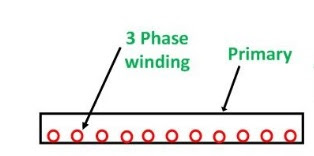Linear Induction Motor (LIM) is an asynchronous motor, working on the same principle an Induction Motor works, but is designed to produce the rectilinear motion, unlike the rotary movement produced by a motor; hence the word Linear Induction Motor. LIM is an advanced version of rotary induction motor which gives a linear translational motion instead of the rotational motion.
Construction of Linear Induction Motor:
The stator is cut axially and spread out flat in Linear Induction Motor (LIM). In this type of motor, the stator and rotor are called primary and secondary respectively. The secondary of the linear induction motor consists of a flat Aluminium conductor with a ferromagnetic core.
For understanding the construction of Linear Induction Motor, we will first take a look at the construction of Induction Motor as shown in figure below.
If we cut the Stator along the line ab and make it flat then the Stator will look like as shown below.
This is what which makes the Primary of a LIM. So Primary of Linear Induction Motor is flat and three phase winding is wound on it. Now if we make the Rotor of Induction Motor flat then it will be nothing but a sheet of flat Aluminium which is called the Secondary of Linear Induction Motor (LIM) as shown in figure below.
Hope construction part of LIM is clear.
Working of Linear Induction Motor:
If a three phase supply is connected to the stator of an Induction Motor, a rotating flux is produced. This flux rotates at a synchronous speed in the air gap. Similarly, if the primary of the Linear Induction Motor is connected to the three phase supply, a flux is produced which will travel across the length of the primary. Because of the travelling magnetic flux, a current will be generated in the conductor which is made of the aluminium material in the secondary of Linear Induction Motor.
This current, which is induced in the LIM secondary interacts with the travelling flux and produces a linear force from i(dL×B). If secondary is fixed and the primary is free to move, the force will move the primary in the direction of the travelling wave. The working principle is depicted in figure below using Double Linear Induction Motor.
Performance of the Linear Induction Motor:
As we know that for a P pole Induction Motor, synchronous speed is given as
Ns = 2f/P rps where f = Frequency of Supply
Therefore, for LIM the speed of travelling flux will be
V = 2f (Pole Pitch) m/s where V = Velocity
The Linear Force is given as,
Power = Force×Velocity
Here Power will be Air Gap Power and velocity will be the velocity of travelling flux.
Force = (Air gap Power) / 2f(Pole Pitch) Newton
Interesting point which shall be noted that,
-
If a rotary induction motor is compared with the linear induction motor, the LIM requires a larger air gap and hence, the magnetising current is greater and the power factor and efficiency of the motor are lower.
-
In the rotary induction motor the stator and the rotor area are same whereas in the LIM the one of the two is shorter than the other. At the steady speed, the shorter part will be passing continuously over a new part of the other member.
Applications of the Linear Induction Motor:
- The main application of the LIM is in transportation and in Electric Traction System. The primary is mounted on the vehicle and the secondary is laid on the track as in Maglav. I will post on use of LIM in magnetic Levitation so be there.
- It is used in the cranes.
- Actuators for the movement of doors
- Used in High voltage circuit breakers and also in accelerators.



